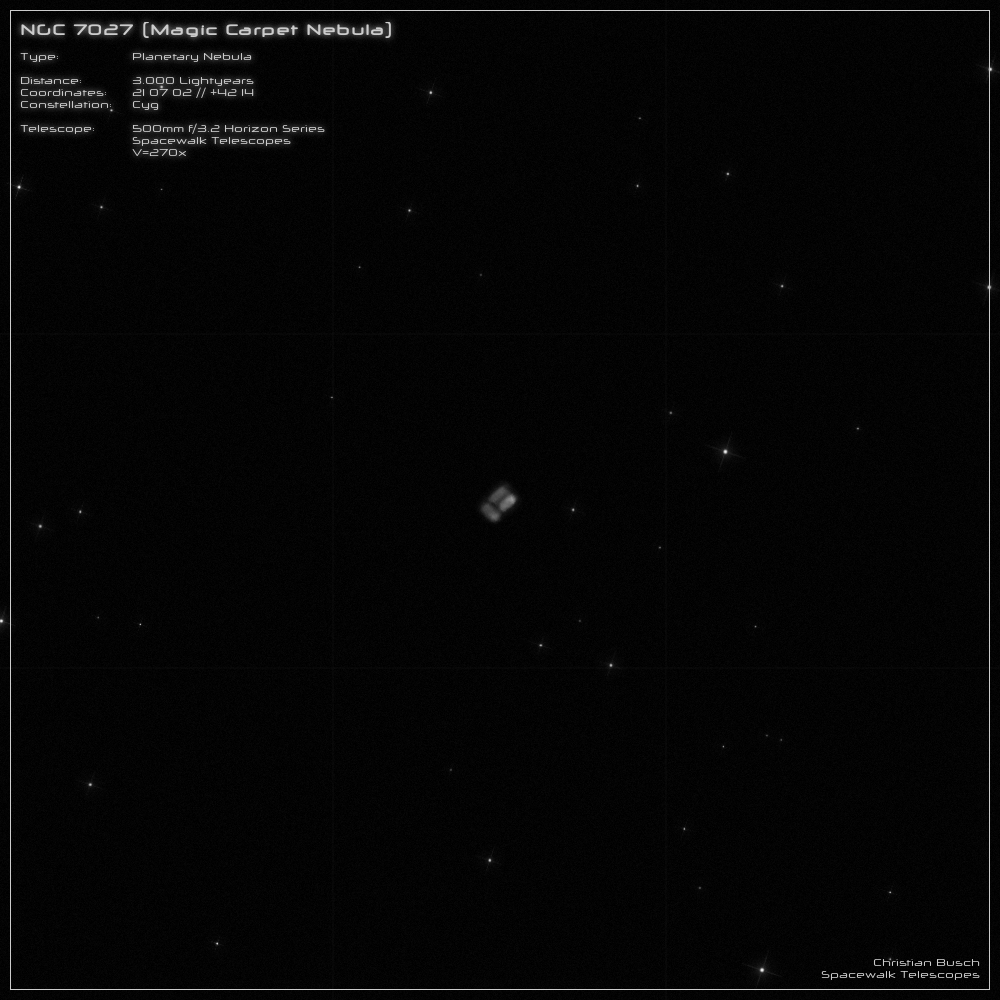NGC 7027, The Magic Carpet Nebula
NGC 7027 is located at a distance of about 3,000 light years in the northern part of the constellation "Swan". With an apparent brightness of 8.4mag
it belongs to the brightest planetary nebulae in the sky. Because of its small size, the surface brightness is quite high, so that the PN can be seen with
smaller telescopes even at full moon. Because of its characteristic shape NGC 7027 is also called "flying carpet".
The apparent extent on the sky is only 18" by 12" (arcseconds). This makes it even smaller than the planetary disk of Saturn and only one third the
size of Jupiter. If you convert the apparent size, you get a true diameter of just 0.2 x 0.1 light years. That is about 1,000 to 2,000 billion kilometers.
This makes it not only one of the smallest planetary nebulae, but also one of the youngest, with an estimated age of only 600 years. When Columbus
discovered America, the nebula was in the process of forming. A pretty cool thing if you ask me ;)
The nebula's envelope is very complex, consisting of an inner shell of very hot ionized gas embedded in another envelope, which in turn is surrounded
by a translucent shell of gas and dust. The expanding envelope is extremely massive compared to other planetary nebulae, at 3-4 solar masses,
suggesting that even very massive stars do not necessarily end up as supernovae. With each second, the nebula expands by another 17 kilometers -
equivalent to the Sun-Jupiter distance in one year. The envelope itself consists largely of carbon, which is also extraordinary. In addition, in 2019, the
"helium hydride ion" was detected, which was the first molecule formed in the universe about 14 billion years ago. In NGC 7027, it was found in free
form for the first time in the present universe. It is also suspected that nano-diamonds have formed in the carbon-rich shell. These are less than
1/1000mm in size, but still: Wow!
But also the central star of NGC 7027 has a lot to offer. Since it is still extremely young, it is still in a phase of shrinking. Even now the surface temperature
has reached 160,000 to 185,000 Kelvin, but the white dwarf will get even hotter. With a remaining mass of 0.7 solar masses and a diameter of about 16,000
kilometers, it is only a little bit larger than the Earth. Due to its extremely high surface temperature, the central star shines as brightly as 7,000 suns and
emits the very largest part of its immensely high radiation in the ultraviolet spectral range. Not a place you would like to be.
----------------------------------------------------------------------------------------------------------------------------------------------
Now that we have read so much about NGC 7027, let's see what of all these exciting things is visible in a 20 inch telescope. The view in the eyepiece
does not reflect at all what one would expect from the many great HST images.
At a magnification of 120x the nebula appears pop green, the brightest parts even fading slightly into bluish. This alone makes the PN worth seeing.
But for the structures you need a much higher magnification. The higher, the better.
The drawing was made at 380x. There is no elliptical envelope to be seen, but rather three elongated spots separated by dark clouds. The brightest
part is in the southwest and is actually a bright knot of the elliptical inner structure. Unfortunately nothing can be seen of the central star. On the one
hand it seems to be partly hidden by dust, on the other hand the bright nebular envelope makes the sighting difficult.
What an exciting object!

